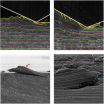(Press-News.org) Researchers have uncovered a way the malaria parasite becomes resistant to an investigational drug. The discovery, at Washington University School of Medicine in St. Louis, also is relevant for other infectious diseases including bacterial infections and tuberculosis.
The study appears July 24 in Nature Communications.
Many organisms, including the parasite that causes malaria, make a class of molecules called isoprenoids, which play multiple roles in keeping organisms healthy, whether plants, animals or bacteria. In malaria, the investigational drug fosmidomycin blocks isoprenoid synthesis, killing the parasite. But over time the drug often becomes less effective.
"In trials testing fosmidomycin, the malaria parasite returned in more than half the children by the end of the study," said senior author Audrey R. Odom, MD, PhD, assistant professor of pediatrics. "We wanted to know how the parasite is getting around the drug. How can it manage to live even though the drug is suppressing these compounds that are necessary for life?"
Fosmidomycin, an antibiotic, is being evaluated against malaria in phase 3 clinical trials in combination with other antimalarial drugs.
Using next-generation sequencing technology, the research team compared the genetics of malaria parasites that responded to the drug to the genetics of malaria parasites that were resistant to it. With this approach, Odom and her colleagues found mutations in a gene called PfHAD1. With dysfunctional PfHAD1, malaria is resistant to fosmidomycin.
"The PfHAD1 protein is completely unstudied," Odom said. "It's a member of a larger family of proteins, and there are almost no biological functions assigned to them."
In malaria parasites, Odom's team showed that the PfHAD1 protein normally slows down the synthesis of isoprenoids. In other words, when present, PfHAD1 is doing the same job as the drug, slowing isoprenoid manufacturing. Since isoprenoids are necessary for life, it's not clear why the organism would purposefully slow down isoprenoid production.
"We don't know why the protein puts the brakes on under normal conditions," Odom said. "Perhaps simply because it's an energetically expensive pathway. But loss of PfHAD1 releases the brakes, increasing the pathway's activity, so that even when the drug is there, it doesn't kill the cells."
Odom says isoprenoid synthesis is an attractive drug target not just for malaria but for tuberculosis and other bacterial infections because these organisms also rely on this same isoprenoid pathway. While people make isoprenoids, these vital compounds are manufactured entirely differently in animals compared with many infectious pathogens likely to cause disease.
Inhibiting isoprenoid manufacturing in malaria, bacteria or tuberculosis, for example, would in theory leave the human pathways safely alone. In people, perhaps the most well-known isoprenoid is cholesterol, with statin drugs famously inhibiting that manufacturing pathway.
Odom, who treats patients at St. Louis Children's Hospital, said she sees a handful of malaria cases each year, mostly in patients who have recently traveled to parts of the world where malaria is common. The parasite remains a massive global health problem, causing about 627,000 deaths in 2012 alone, according to the World Health Organization. Most deaths are in children under age 5.
Despite this public health burden, malaria is understudied in the lab because it is notoriously difficult to grow. It has a complex lifecycle that includes two-way transfers between mosquito and human and spans different forms in the human liver and red blood cells.
"The malaria parasite is difficult to work with in the lab; it's nearly impossible to replicate the lifecycle," Odom said. "That's why it was so exciting to be able to do this kind of study in malaria, rather than in a typical model organism like yeast. This genetic study would not have been possible even five years ago because the gene sequencing technology was not there."
INFORMATION:
This study was supported by grants from the Children's Discovery Institute of Washington University and St. Louis Children's Hospital (MD-LI-2011-171), the National Institute of Allergy and Infectious Diseases (NIAID) of the National Institutes of Health (NIH) (R01AI103280), the March of Dimes, the Doris Duke Charitable Foundation, the National Institute of General Medical Sciences (NIGMS) of the NIH (5T32GM007067), the Monsanto Excellence Fund, a Sondra Schlesinger Graduate Student Fellowship from Washington University, an HHMI Summer Scholars Undergraduate Research Fellowship, an ASM Undergraduate Research Fellowship and the Amgen Scholars Program at Washington University.
Guggisberg AM, Park J, Edwards RL, Kelly ML, Hodge DM, Tolia NH, Odom AR. A sugar phosphatase regulates the methylerythritol phosphate (MEP) pathway in malaria parasites. Nature Communications. July 24, 2014.
Washington University School of Medicine's 2,100 employed and volunteer faculty physicians also are the medical staff of Barnes-Jewish and St. Louis Children's hospitals. The School of Medicine is one of the leading medical research, teaching and patient-care institutions in the nation, currently ranked sixth in the nation by U.S. News & World Report. Through its affiliations with Barnes-Jewish and St. Louis Children's hospitals, the School of Medicine is linked to BJC HealthCare.
One route to malaria drug resistance found
2014-07-24
ELSE PRESS RELEASES FROM THIS DATE:
New methods of detecting Salmonella in pork meat processing
2014-07-24
Traditional methods of characterising and detecting bacteria are often slow and time-consuming. Therefore, development of new methods of characterising and detecting illness-causing microorganisms is very important for improving food safety.
Trine Hansen, PhD student at the National Food Institute, has studied new methods of characterising Salmonella in pork meat processing and detecting unknown bacteria in water, feed and food samples.
The research project has given a better understanding of which factors in pork meat processing may contribute to the development of ...
Chemist develops X-ray vision for quality assurance
2014-07-24
It is seldom sufficient to read the declaration of contents if you need to know precisely what substances a product contains. In fact, to do this you need to be a highly skilled chemist or to have genuine X-ray vision so that you can look directly into the molecular structure of the various substances. Christian Grundahl Frankær, a Postdoc at DTU Chemical Engineering, is almost both, as he has developed a method that allows him to use X-rays to look deep into biological samples.
The 'Fingerprints' of a Substance
The technique is called 'powder diffraction' and involves ...
Unleashing the power of quantum dot triplets
2014-07-24
Quantum computers have yet to materialise. Yet, scientists are making progress in devising suitable means of making such computers faster. One such approach relies on quantum dots—a kind of artificial atom, easily controlled by applying an electric field. A new study demonstrates that changing the coupling of three coherently coupled quantum dots (TQDs) with electrical impulses can help better control them. This has implications, for example, should TQDs be used as quantum information units, which would produce faster quantum computers due to the fact that they would be ...
Tempting people to move for work takes more than dollars
2014-07-24
Sufficient financial inducements are one way of encouraging people to move to regional Australia for jobs, but other factors also play a part, according to a new report.
Moving workers from a region with high unemployment to a region with many job vacancies is an important aspect of labour markets. The Commission of Audit recently advised the government to "force" long-term unemployed people who are single and between the ages of 22 and 30 to move to areas of higher employment if they have been on the dole for 12 months.
Researchers from Monash and Deakin Universities ...
Study reveals medical students believe health policy education is improving
2014-07-24
Philadelphia – Students graduating from U.S. medical schools in 2012 feel they've received a better education in health policy issues than graduates surveyed in 2008, according to a multi-center study led by the Perelman School of Medicine at the University of Pennsylvania, and published online this month in Academic Medicine. The study applied a new framework for teaching and evaluating perceptions of training in health policy, first proposed by the authors in a 2011 perspective published in the New England Journal of Medicine.
"Our prior work found that for nearly a ...
Discovery is key to metal wear in sliding parts
2014-07-24
WEST LAFAYETTE, Ind. – Researchers have discovered a previously unknown mechanism for wear in metals: a swirling, fluid-like microscopic behavior in a solid piece of metal sliding over another.
The findings could be used to improve the durability of metal parts in numerous applications.
"Wear is a major cause of failure in engineering applications," said Srinivasan Chandrasekar, a Purdue University professor of industrial engineering and materials engineering. "However, our findings have implications beyond wear itself, extending to manufacturing and materials processing."
The ...
Highest-precision measurement of water in planet outside the solar system
2014-07-24
A team of astronomers using NASA's Hubble Space Telescope have gone looking for water vapour in the atmospheres of three planets orbiting stars similar to the Sun – and have come up nearly dry.
The three planets, HD 189733b, HD 209458b, and WASP-12b, are between 60 and 900 light-years away, and are all gas giants known as 'hot Jupiters.' These worlds are so hot, with temperatures between 900 to 2200 degrees Celsius, that they are ideal candidates for detecting water vapour in their atmospheres.
However, the three planets have only one-tenth to one-thousandth the ...
Wives with more education than their husbands no longer at increased risk of divorce
2014-07-24
WASHINGTON, DC -- For decades, couples in which a wife had more education than her husband faced a higher risk of divorce than those in which a husband had more education, but a new study finds this is no longer the case.
"We also found that couples in which both individuals have equal levels of education are now less likely to divorce than those in which husbands have more education than their wives," said Christine R. Schwartz, lead author of the study and an associate professor of sociology at the University of Wisconsin-Madison. "These trends are consistent with ...
Warning: Birthdays can be bad for your health
2014-07-24
New research has found that birthday-related drinking is associated with upsurges in hospital admissions among young people. This study of drinking behaviour in Ontario, Canada is published online today in the scientific journal Addiction.
Researchers, led by University of Northern British Columbia Associate Professor of Psychiatry Dr. Russ Callaghan, analysed records from all hospital admissions in Ontario over a five-year period (2002-07) involving people aged 12 to 30 years. They discovered that during the week in which Ontarians turned 19 – the legal drinking age ...
Experiments prove 'stemness' of individual immune memory cells
2014-07-24
The immune system has evolved to recognize and respond to threats to health, and to provide life-long memory that prevents recurrent disease. A detailed understanding of the mechanism underlying immunologic memory, however, has remained elusive. Since 2001, various lines of research have converged to support the hypothesis that the persistence of immune memory arises from a reservoir of immune cells with stem-cell-like potential. Until now, there was no conclusive evidence, largely because experiments could only be carried out on populations of cells. This first strict ...




